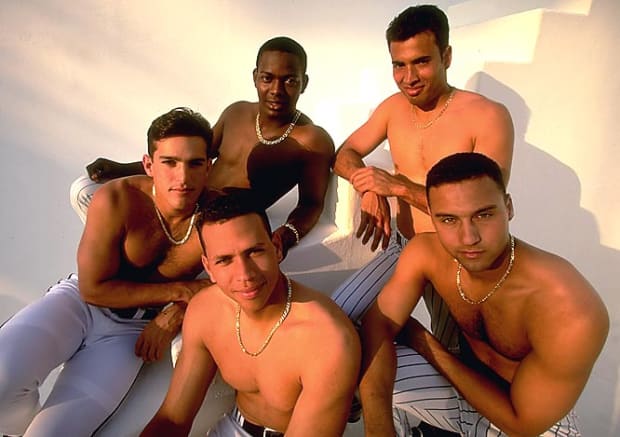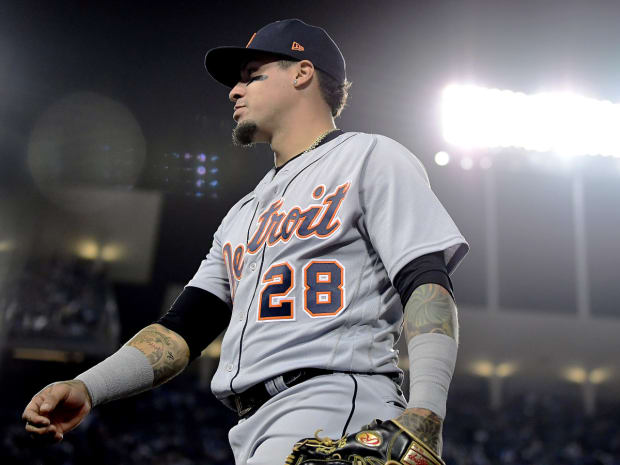They are off to disappointing starts with their new teams after signing mega deals this offseason. Is it time to panic?
Welcome to The Opener, where every weekday morning during the regular season you’ll get a fresh, topical story to start your day from one of SI.com’s MLB writers.
Twenty-five years ago—long before Avengers: Infinity War staked its claim to this title—the most ambitious crossover event in history took place. High art and baseball became intertwined in the form of a monumental photo shoot featuring a quintet of then young shortstops (you know the one). One could argue that the shortstop position, photography and life itself were forever changed.

Walter Iooss Jr./SI
The 2021 shortstop free-agency class did not venture into the waters of tasteful nude photography (the key word is tasteful, after all), but there was certainly a similar level of buzz surrounding the group. Corey Seager, Carlos Correa, Marcus Semien, Javier Báez and Trevor Story made up five of our top-12 free agents entering this offseason, and all five inked nine-figure deals worth a combined $885.3 million.
We’re just over five weeks into the start of the 2022 season, though, and none of the above stars have lived up to the billing so far (though some have certainly fared worse than others). The root of each player’s struggles is different, with varying degrees of long-term concern. Let’s check in on each of the five shortstops below, and decide how concerned each fan base should be about their current form.
Note: All stats reflect games through Monday, May 16.
Corey Seager, Rangers
Less than three weeks ago, the concern level for Seager would have been considerably higher. Through his first 17 games, the former Dodgers star slashed a meager .243/.290/.300, showing no power to speak of with just two extra-base hits in 76 plate appearances. Since then, though, he’s begun to resemble his old self. Seager has just 13 hits in his last 16 games, but six of them have been homers. He still has strong contact skills (16.9% strikeout rate), and his added launch angle should lead to even more long balls in the future. His peripherals are encouraging, so even if he hasn’t yet performed like the Rangers likely had hoped, better times are likely on the way.
Panic Meter: 2/10
Carlos Correa, Twins
Correa is the only one of these five currently not active, though his stint on the injured list with a bruised finger should be the minimum 10 days. Before his injury, the two-time All-Star had started to heat up offensively after struggling to find his stride at the plate. In his last eight games before hitting the IL, Correa raised his season OPS from .504 to .693, posting a .412/.444/.588 slash line in that span.
With the good-sized caveat that five weeks’ worth of games is an incredibly small sample size, the early defensive metrics for Correa show some decline. After leading the majors with 21 defensive runs saved in 2021, he ranks 18th so far this season. Statcast, meanwhile, ranks him in the 20th percentile in outs above average at his position. Correa won his first Gold Glove last year and is still only 27, so any meaningful physical decline shouldn’t arrive for at least the next few years. As long as the bat performs, gradual slips in defense will be more than acceptable for the Twins.
Panic Meter: 3.5/10

Gary A. Vasquez/USA TODAY Sports
Javier Báez, Tigers
Báez’s player profile has seemingly been the same since he arrived in the big leagues: strong, highlight-heavy defense with inconsistent hitting. Through his first 27 games in Detroit, the tendency to swing and miss too often has followed him from Chicago, which has greatly hindered his productivity at the plate.
Always a free swinger, Báez has chased pitches outside the zone more often (47.0%) than he ever has before, which has produced a career-worst 22.0% swinging strike rate. When he does make contact, it’s weaker than it has been in the past, and his 55.7% ground ball rate has completely sapped his power. It’s hard to see him replicate another 30-homer season anytime soon unless his approach at the plate alters sooner rather than later. Then again, maybe we shouldn’t doubt El Mago just yet.
Panic Meter: 6.5/10
Trevor Story, Red Sox
Story was the last of this bunch to sign, and he got the exact same deal as Báez. If Báez has been a disappointment, Story’s Red Sox career thus far has been a complete disaster. The former All-Star battled contact issues earlier in his career but had relatively stable and acceptable strikeout rates over the past several seasons. So far, he’s struck out at a 31.3% clip with no power.
He’s making weaker contact than ever before, and his career-high 23.8-degree launch angle has led to an obscene 17.9% infield fly ball rate. Once an above-average defensive shortstop, he hasn’t exactly wowed with his move to second base, either. A miserable April has given way to a somehow worse May, and right now it’s hard to see the silver lining. It’s early, and Story is simply too good a player to perform this poorly for much longer. But the longer it takes him to snap out of his funk, the further behind Boston will fall in the AL East race.
Panic Meter: 8/10
Marcus Semien, Rangers
Man, where to begin? I’m fudging a bit here since Semien has been a second baseman each of the past two seasons, but his primary position before then was shortstop, and he would almost certainly be manning that position if the Rangers had not signed Seager.
Semien was an MVP finalist in two of the last three years but has looked completely lost since arriving in Arlington. His issues are manifold, but broadly he simply is not making hard contact at all. His 25.2% hard-hit rate is down from 41.3% from a season ago and ranks fifth-worst in the league among qualified hitters. After hitting .298 with a .623 slugging percentage against fastballs in 2021, this year he’s been completely overpowered by the heater. Semien is managing just a .149 average and a woeful .209 slugging percentage on the nearly 300 fastballs he’s seen this season. After setting the record for most home runs by a second baseman in a single season, he’s yet to leave the yard in ’22.
It’s difficult to envision him being this bad for much longer, given his track record of at least being an above-average regular. Texas has invested $175 million in Semien over the next seven years, so a benching is virtually impossible. In the meantime, the team will have to be patient and hope things turn around sooner rather than later. But by any metric available, Semien has been abysmal, so the Panic Meter cannot be set high enough.
Panic Meter: 10/10
More MLB Coverage:
• The Yankees Are the Class of MLB This Season
• MLB Power Rankings: The Dodgers Are Finally Dethroned
• Inside the Reds’ Historically Bad Start to the Season
• Hitter, Pitcher, Prankster: Shohei Ohtani Is a Triple Threat
• Five-Tool Newsletter: Gleyber Torres Is Better Than Ever